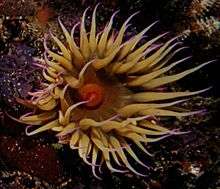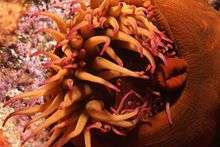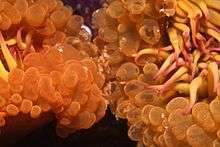Pseudactinia flagellifera
Pseudactinia flagellifera, the false plum anemone, is a species of sea anemone in the family Actiniidae.[1] It is also a member of the kingdom, Animalia.
| Pseudactinia flagellifera | |
|---|---|
 | |
| Scientific classification | |
| Kingdom: | Animalia |
| Phylum: | Cnidaria |
| Class: | Anthozoa |
| Order: | Actiniaria |
| Family: | Actiniidae |
| Genus: | Pseudactinia |
| Species: | P. flagellifera |
| Binomial name | |
| Pseudactinia flagellifera (Drayton in Dana, 1846) | |
Description

The false plum anemone is a large anemone of up to 20 cm in diameter. It has a smooth column that may be orange, yellow or red. The tips of its tentacles are often mauve. It has a protruding round mouth, and the oral surface may be striped. It has rows of small round protrusions (spherules) outside its tentacles.[2]
Distribution
It is found around the southern African coast from Luderitz to Durban. It is also found around Madeira. It inhabits waters from the intertidal to 35m in depth.
Ecology
The false plum anemone cannot easily retract its tentacles.

It preys mostly on molluscs, and has been reported to have a serious sting which can affect humans. It is able to move about slowly and maintains territory by stinging genetically unrelated anemones with its spherules.[2]
References
- Branch, G.M., Branch, M.L, Griffiths, C.L. and Beckley, L.E. 2010. Two Oceans: a guide to the marine life of southern Africa ISBN 978-1-77007-772-0
- Jones, Georgina. A field guide to the marine animals of the Cape Peninsula. SURG, Cape Town, 2008. ISBN 978-0-620-41639-9
| Wikimedia Commons has media related to Pseudactinia flagellifera. |